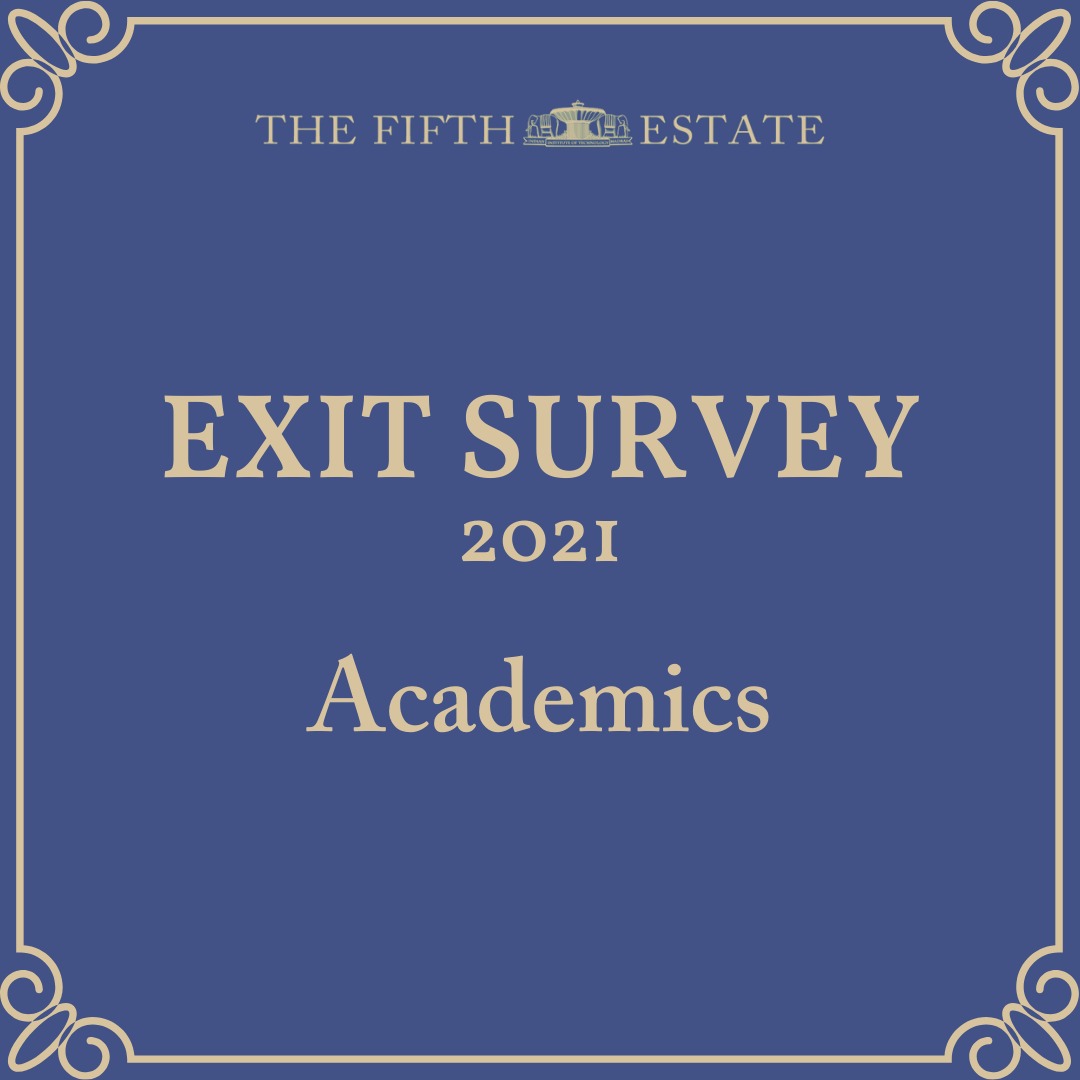Edited by Jai Santhoshi
Attention: If you are reading this article on a mobile phone, use Desktop View for best reading experience
Note: T5E’s Exit Survey 2021 was conducted in the month of June to study graduating student’s perspectives of life at IIT Madras. The survey had a total of 374 responses across the entire 2020 graduating class (UG + PG) answering the survey out of which, around 65% of the participants were UG’s (B.Tech + DD+ MA), and the rest were PG’s (MSc + MTech + MBA + PhD + MS).
The exit survey conducted by T5E revealed the disparities in the student strengths at various academic aspects. The following graphs depict the degree pursued and branch composition of the respondents.
When asked about the departments favoured by the students, it was found that around 24% of the students did not get an opportunity to try out the courses of other departments. Moreover, PG students did not try out other department courses as much as the UG students. An explanation to this might be the preference of students to choose electives from their department.
Regardless of their academic workload, around 45-50% of the B.Tech, MBA, DD, and MA students made sure that they had tried everything they wanted to do. While 59% of PhD students had tried out all the things they wanted to, the PGs, broadly speaking, felt that they could have explored more if their coursework had been a little lighter.
1. CGPA and Way of Studying
An interesting insight gained from the survey was that most of the students from B.Tech, M.Tech, MA and MBA preferred to study for their exams at the last moment rather than opting to study everything from the start.
As opposed to the common notion that only studying from the beginning can get you high grades, the survey showed that despite the short term study period, the CGPA of most students continued to range between 7-9.
The relationship between the pattern of study and CGPA satisfaction was also drawn out from the survey. 71% of the students who studied regularly showed complete satisfaction with their CGPA. Still, interestingly around 45% of the students who engaged in last moment preparation found the same amount of satisfaction. Some of the reasons for this could be that they did not want a very high CGPA in the first place and had other interests extending beyond learning to score in the exams.
The help provided by the TAs were rated a 3 (out of 5) by both Dual Degree and B. Tech students.
B.Tech, Dual Degree, and MA students spent an average of 2-3 hours per day studying, whereas the postgraduates and the research scholars spent around 4-7 hours per day. Another intriguing find was that those engaged in fewer study hours were less satisfied with their CGPA as compared to those who studied for more than 5 hours a day.
The survey found that 52% of the students found it convenient to study from their own rooms compared to 24% from the library and an even lesser 16% utilising the department facilities. Minimal distraction might be a reason for the majority of students choosing to study from their rooms. The utilisation of department facilities might be higher amongst the PG students due to the higher practical nature of their work, which involves the use of labs and other facilities. A mere 1% of students found Hostel Reading Rooms to be the most convenient place of study, which could be due to poor maintenance and disturbance.
2. Facilities for Project Work
More than 50% of all the students except MA and B.Tech students felt that there were adequate facilities and resources to complete their project work, while 38% of the MA students felt that there weren’t enough resources available to them. A possible explanation for such an outcome could be the decreased attention given to the facilities of the MA students.
3. Alignment of the current branch with future goals
When asked if their branch would help them pursue their goals after stepping out of the institute, 29% of the B.Tech and Dual Degree students rated the possibility a scant 1 out of 5. This also reinstates the popular notion that most of the students do not pursue a job in their department of study and prefer non-core jobs instead. However, more than 50% of the postgraduate level students – M.Tech, MBA, MSc, MS, PhD and MA students rated 3 or 4 out of 5 and around 20-25% also rated a 5 on 5.
The increased specificity offered by the postgraduate courses that help the students align their passions and interests better might be the reason for this increased rating amongst them and the cause for an increased interest in their coursework compared to the undergraduate students.
4. The pros of IDDD
The survey revealed that around 15% of the dual degree students converted to IDDD due to various advantages they found in pursuing it.
While around 50% of the students felt that choosing IDDD helped them explore a subject of interest, 25% found that it aided in getting them better job opportunities. About 30% of the students found it worth spending an extra year, and a minuscule percentage regretted choosing IDDD.
5. Benefits of Branch Change and the Fraction of students engaged in it
Around 83% benefitted from a branch change and emphasised that they wouldn’t have had the opportunity to pursue their interests in their previous branch. They also considered the branch change as a turning point in their career.
Naturally, 94.6% of the students did not engage in a branch change. The surrounding reasons can be the number of students allowed a branch change or the fear of changing from a level of comfort gained at the current department.
It is also noticed that B.Tech students had a more positive experience regarding a branch change than Dual Degree students. When enquired, it was found that Dual Degree students get more time to explore opportunities within their branch, and the possibility of finding opportunities in their original branch was higher owing to the extra time available.
CS continues to remainthe most popular branch amongst students, followed by CH and EE.
Research Scholars
The exit survey 2021 increased focus on the academic issues surrounding research scholars, i.e., PhD and MS students, especially regarding various aspects of their research in the institute and the problems faced by them.
1. Financial Help and impact on society
Around 74% of the research scholars took financial help for their conference or paper presentations. The percentage of research scholars who avail financial help is 83% amongst the PhD scholars while it is 63% amongst the MS students. The more demanding nature of the projects undertaken by the PhD students might be a reason for this.
The perceived impact that the research has on the current society varies from 70 – 90% amongst the PhD students and 50 – 80% amongst the MS students. There could also be a mutually reinforcing relationship between financial support and social impact – higher financial support allows PhDs to take on projects with greater impact and PhDs might be receiving better support because their research tends to benefit society relatively higher.
2. The relation between freedom to choose Research topics and courses with the number of papers published
A majority of the students felt that there was enough freedom to choose their research topics and courses. In comparison, 6% of MS students and 11% of PhD students found that they did not have much freedom. Lack of sufficient resources in conducting in-depth research on the topic or pressure from their guides to take up a more popular topic could be a reason for this.
Around 92% of the MS students and 69% of the PhD students published 0-5 papers. Contrastingly, only 6% of the PhD students and none of the MS students published more than 10 papers.
3. Responsiveness of Guides and Learning Experience
More than 50% of both the PhD and MS students rated the responsiveness of guides as 5 out of 5. The increased responsiveness of the guides helped improve the students’ learning experience and thereby supplement the academic development of the students. It is also seen that with enhanced help from the guide, the learning experience of the scholars improved. The gaining of insights from a much more experienced person in the field would also help them improve the quality of their work.
4. Management of insufficient resources
A Majority of the PhD students felt that there were necessary resources, but not enough for everyone. In the absence of essential resources, they reached out to other departments for help instead of changing research topics – which also shows the effort put in by the research scholars and the commitment towards their work.
Take a look at other articles in the Exit Survey 2021: https://www.t5eiitm.org/exit-survey-2021-extracurriculars/






The data is really useful but please change the color scheme. It’s really hard to identify regions in those blue pie charts.